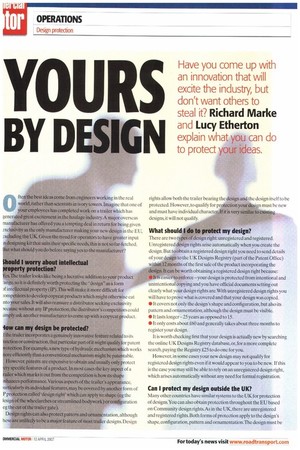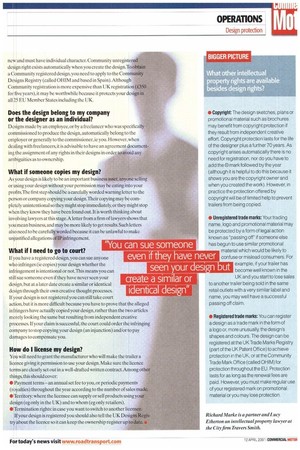YOURS BY DESIGN
Page 62

Page 63

If you've noticed an error in this article please click here to report it so we can fix it.
0 , ben the best ideas come from engineers working in the real world, rather than scientists in ivory towers. Imagine that one of your employees has completed work on a trailer which has generated great excitement in the haulage industry A major overseas manufacturer has offered you a tempting deal in return for being given 2xclusivny as the only manufacturer making your new design in the EU, 2X cluding the UK. Ciiven the trend for operators to have greater input n designing kit that suits their specific needs, this is not so far-fetched. But what should you do before saying ves to the manufacturer?
;hould I worry about intellectual property protection?
Ves.The trailer looks like being a lucrative addition to your product .ange. so it is definitely worth protecting the "design" as a form 3f intellectual property ( IP).This will make it more difficult for :ompetitors to develop copycat products which might otherwise eat nto your sales. It will also reassure a distributor seeking exclusi ity )ecause without any IP protection, the distributor's competitors could ;imply ask another manufacturer to come up with a copycat product.
low can my design be protected?
I the trailer incorporates a genuinely innovatiVt; to its unction or construction, that particular part of it might qu r patent >rotection.For example. a new type of hydraulic mechan h works nore efficiently, than a conventional mechanism might be pat table. However. patents are expensive to obtain and usually only otect 'cry specific features of a product. In most cases the key as!. 'of a railer which marks it out from the competition is how its shape 'nhances perform a nce.Various aspects of the trailer's appearance, articularly its individual features, may he covered by another form of P protection called 'design right' which can apply to: shape (clithe lesign of the wheelarches or streamlined bodywork) or contip ration eg the cut of the trailer gate).
Design rights can also protect pattern and ornamentation, although hese are unlikely tube a major feature of most trailer designs.Design rights allow both the trailer bearing the design and the design itself to be protected. However, to qualify for protection your design must he new and must have individual character. if it is very similar to existing . designs, it will not qualify.
What should I do to protect my design?
There are two types ot design right: unregistered and registered. Unregistered*sign rights arise automatically when you create the design. But to obtain a registered design right you need to send details of your design to the UK Designs Registry (part of the Patent Office) w it bin 12 months of the first sale of the product incorporating the design. It can be worth obtaining a registered design right because: . easier to enforce -your design is protected from intentional and unintentional copying and you have official documents setting out clearly what your design rights are.With unregistered design rights you will have to prove what is covered and that your design was copied.
• It covers not only the design's shape and configuration, but also its pattern and ornamentation, although the design must be visible.
• It lasts longer -25 years as opposed to 15.
• It only costs about £60 and generally takes about three months to register your design.
It is worth checking first that your design is actually new by searching the online UK Designs Registry database,or,for a more complete search, paying the Registry £25 to do one for you.
However, in some cases your new design may not qualify for registered design rights even if it would appear to you to be new. If this is the case you may still be able to rely on an unregistered design right, which arises automatically without any need for formal registration.
Can I protect my design outside the UK?
Many other countries have similar systems to the UK for protection of designs. You can also obtain protection throughout the EU based on Community design rights. As in the UK, there are unregistered and registered rights. Both forms of protection apply to the design's shape, configuration, pattern and ornamentation.The design must be nesAl and must have individual character. Community unregister design right exists automatically when you create the design.TO a Community registered design, you need to apply to the Corn Designs Registry (called OHIM and based in Spain). Although CoMmunity registration is more expensive than UK registratio for five years), it may be worthwhile because it protects your des all 25 EU Member States including the UK.
Does the design belong to my company or the designer as an individual?
Designs made by an employee, or by a freelancer who was specifica commissioned to produce the design, automatically belong to the toyer or generally to the commissioner, ie you. However, when ing with freelancers, it is advisable to have an agreement he assignment of any rights in their designs in orde ambiguities as to ownership. em de ing
What if someone copies my design?
As your design is likely to be an important business asset. anyone selling or uSing your design without your permission may be eating into your prohts.The first step should be a carefully worded warning letter to the person or company copying your design.Their copying may be completely unintentional so they might stop immediately, or they might stop when they know they have been found out. It is worth thinking about involving lawyers at this stage.A letter from a firm of lawyers shows that you mean business, and may be more likely to get results Such letters alsO need to be carefully-worded because it can be unlawful to make unjustified allegations JPrnfrrngemcnt.
What if I need to go to court?
If you have a registered design, you can sue anyone who infringes (ie copies) your design whether the infringement is intentional or not.This means you can still sue someone even if they have never seen your des go. but at a later date create a similar or identical design through their own creative thought processes. If your design is not registered you can still take court action, but it is more difficult because you have to prove that the alleged infringers have actually copied your design,rather than the two articles merely looking the same but resulting from independent creative processes If your claim is successful, the court could order the infringing company to stop copying your design (an injunction) and/or to pay dariagcs to compensate you.
How do I license my design?
-1-0.1 will need to grant the manufacturer who will make the trailer a licence giving it permission to use your design. Make sure the licence terns are clearly set out in a well-drafted written contract. Among o things, this should cover: • Oayrnent terms an annual set fee to you, or periodic payments (royalties) throughout the year according to the number of sales ma • Territory: where the licensee can supply or sell products using yo deSign (eg only in the UK) and to whom (eg only retailers). *Termination rights: in case you want to switch to another licensee.
If your design is registered you should also tell the UK Designs Registry about the licence so it can keep the ownership register up to date. mi


















































































































































































